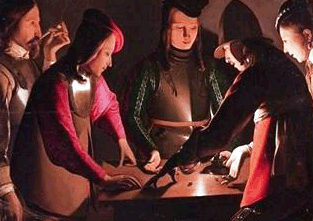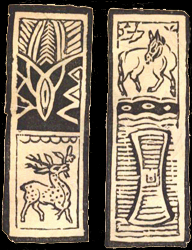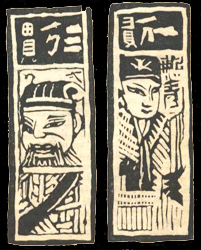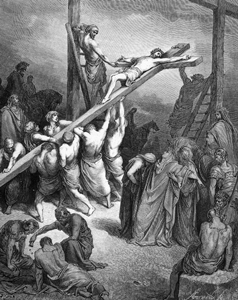 |
Progress Publishing Co. |
 |
|
A History of Gambling |
 |
Progress Publishing Co. |
 |
|
A History of Gambling |

![]()

![]()
Origin, History and Evolution
of Gambling
*******************************************************************
Origin of Gambling and Gambling Tools
A History of Gambling in Mesopotamia, Ancient Persia, Egypt, India and China
A History of Gambling in Greco-Roman Period
A History of Gambling in Medieval Europe
A History of Online Gambling
*******************************************************************
I) Origin of Gambling and Gambling Tools
Origin of Gambling
The beginning of gambling and gambling tools can be traced to religious rituals in primitive pre-historic societies. Those pagan rituals had a purpose of foretelling the future or explaining what was beyond comprehension. The procedure of the rituals was simple and consisted of casting the lots – throwing small objects like pebbles, sticks, nuts, arrows etc. out of the palms of the hands or any primitive container. The result was checked to see if the number of the objects on the ground was “odd” or “even”. “Even” number usually meant a positive outcome and interpretation, when “odd” stood for a negative one. With time that process became more complicated and involved also interpreting the patterns of the objects lying on the ground. The next step in the evolution of these rituals included the sacrifices from the participants to encourage the Fate or the Gods to deliver positive signs and help. The sacrifices were first personal stakes which turned those involved from mere observers into active players of the process. They gambled their stakes on the outcome that depended on Chance only. Eventually the same type of chance-based procedures expanded into every day life. Gambling grew out of religious rituals into a separate activity, which helped with decision making process like who will get a better piece of a killed prey or get himself a better looking woman. The final step in that evolution toward pure gambling happened when people decided to gamble with their stakes for material gain only.
This evolutionary point of view on gambling origins is accepted by modern history and anthropology. Ancient explanations credited Gods and mythological heroes with the invention of gambling. For ex, the Egyptians thought that god Thoth who was the divine physician, inventor of writing and supreme judge invented gambling. For ancient Greeks gambling also came from Gods. According to Greek Mythology, Zeus, Poseidon and Hades were casting lots to claim parts of the Universe. In result Zeus got the heavens, Poseidon the sea and Hades took possession of the underworld. Later Greeks decided that mythological hero Palamedes created games of chance to entertain Greek troops during the Trojan War. He was also thought to be the inventor of the dice.
Origin of Gambling Tools
Like gambling evolved from divinatory practices of early societies, gambling tools evolved from the objects employed in those rituals. The objects used were easily accessible to a primitive man – stones, sticks, nuts, bones etc.
Small bones such as knucklebones (astragali) became the direct predecessors of the modern dice. Astragali have an irregular, not symmetrical shape, which has 4 large sides and two more or less rounded ends. After being thrown, an astragalus will stop on one of its 4 big sides delivering a quasi-random outcome of the throw. Eventually the sides of an astragalus were given value and markings. The lowest value of one was attached to the largest side of a concave shape because of a higher chance that the bone will rest on it. The highest value of 6 was given to the smallest side of a convex shape for the obvious reason.

Astragali (Source Sifakis 1990)
Astragali were
usually used in pairs or in threes. The games with astragali had an object of
throwing the highest number or the number that is equal or exceeds a
predetermined one. Knucklebones were in use until Romans started using other
materials to manufacture dice of a symmetrical shape and even density to produce
more random results. Among the materials the most used were ivory, stone, wood,
amber and animal and human teeth. Some dice were shaped like pyramids but the
most popular were six-sided cubes, which are used today. The cubical dice from
around 3000 B.C. were found in Mesopotamia region and from 2000 B.C. in Egypt.
Dice evolved from the specific tools - astragali - of religious rituals. The same way the origins of the playing cards can be connected to divinatory practices. Specifically, the symbolic sacred arrows used for fortune telling around 6th Century A.D. in Korea became the forerunners of modern cards. Korean early cards made of oiled paper and silk were called Htou-Tien or “fighting arrows”. Later on these cards were modified by Chinese on the basis of paper money design.
 |
 |
|
| Chinese | Cards |
Indian Round Cards |
Before the invention
of the printing press in the 15th Century the
cards were hand-made with
stencils and woodblocks. In result, the price of the pack was too expensive for
the ordinary folks. In medieval Europe aristocracy used the services of painters
including some of the great Renaissance painters to create nice looking decks of
cards. Printing press made them affordable for masses and
the cards rapidly spread
all over Europe in the end of the 15th Century.
II) A History of Gambling in Mesopotamia, Ancient Persia, Egypt, India and China
Around 7000 B.C. the
fertile soil of Mesopotamia – the region between Tigris and Euphrates in modern
Iraq – gave humans the first opportunity to change lifestyle from nomadic to a
settled one. That led to establishing of a stable society, which was necessary
for developing skills, knowledge and tools. The civilization of the human race
started from that point in history. No wonder that the earliest gambling tools
were discovered among archaeological findings in that part of the world.
Four-sided astragali
dating 6000 B.C. and first six-sided dice cubes marked with pips dating 3000
B.C. were found in many archaeological sites. Discovered gaming boards from the
same period revealed that the population played board games structurally similar
to modern Backgammon. The result of the throw of the dice was used to determine
how far a game piece could be moved on the board.
Gambling with dice was very popular in Persia, which covered the territory of modern Iran. Greek historian and biographer Plutarch told the story about a dice game between King Artarxerxes and his mother Parysatis. Sometime before the game the King ordered one of his servants to cut the head of his younger brother Cyrus who had attempted a coup to grab the power but had been defeated in the battle. Parysatis wanted to revenge Cyrus. She offered Artaxerxes to play a friendly dice game. She lost on purpose to entice the King to play for higher stakes. The stakes included the servant who beheaded Cyrus. The Mother Queen proceeded to win and take a revenge on that servant.
Egyptians liked to
gamble as much as their Persian and Mesopotamian brothers in gambling. Ancient
Egyptian tombs were adorned by sculptural reliefs depicting numerous gambling
scenes. Survived hieroglyphic records from old dynasties show that anti-gambling
laws were established by 3000-4000 B.C. That means that by that time gambling
was already a significant part of the Egyptian life. Plutarch recorded an
Egyptian myth about the gods who gambled. Cubical dice dating back to 2000 B.C.
have been found in archaeological excavations.
Most of the games
played by the Egyptians involved 2 dice and a gaming board. The dice were tossed
and the game pieces were moved across the board according to the result of the
throw. A player who moved his pieces across the whole board first was a winner.
Other forms of
gambling included “Odds and Evens” games and also guessing games. In guessing
games the players had to guess correctly how many fingers were extended by an
opponent or how many small objects he had in his hand.
Indian culture adopted
gambling from the beginning of Indian civilization, which started 4000 years
ago. Great Indian epic Mahabharata dating to 1500 B.C. has the main story, which
starts with a dice match. Different members of a royal family competed for the
throne. Finally it came down to a dice game. The game was not honest probably
thanks to the loaded dice. One of the competitors lost all his royal possessions
including his wife. The story, however, has a happy ending.
Unlike Mesopotamians
who used astragali for dice games, Indians employed the nuts of the “vibhitaka”
tree (Schwartz 2006). These nuts have 5 more or less flat sides, which make it
possible to use them as dice. Eventually vibhitaka dice were replaced by
astragali and cubical dice.
Besides dice games
Indians were fond of gambling that involved animals – particularly cock and ram
fights.
There were many
gambling houses for gamblers to assemble and play like there was no tomorrow.
Those houses were supervised by an official to assure orderly gambling and
collect from the players a percentage for the King.
Chinese gambling
tradition is second to none. Gambling followed the development of Chinese
society every step of the way and by 1000 B.C. it became as inseparable from
Chinese culture as wonton soup or a roasted duck. Every big street in Chinese
towns had a gambling den. Very popular form of gambling was betting on animal
fights and races. Cricket and cock fights and dog and horse races always
attracted huge number of gamblers and heavy betting.
In the 5th
Century B.C. board games, which combined luck and skill grew in popularity.
Around 7th Century A.D. Chinese modified western dice into Chinese
dominoes. The dominoes included 31 pieces representing 21 numbers (some numbers
were repeated). They were made of ivory and other materials and usually had red
and black pips. In 12th Century A.D. during the rule of Emperor Seun-Ho
Chinese playing cards entered the gambling scene giving another boost and adding
another flavor to already rich and diverse gambling life in China.
III) A History of Gambling in Greco-Roman Period
Gambling in ancient Greece can be divided in 3 categories:
1) Simple games, 2) Gambling involving dice and 3) Gambling around animal and human contests.
Simple games required
correct guessing of the game result. In “Odds and Evens” games a player had to
make a correct guess about the number of small objects (pebbles, nuts etc.) held
by an opponent being an odd or even number. In another games Greeks tossed the
shells that were black on one side and white on the opposite one. The players
tried to predict the result of the toss to be the “night” (black side) or a
“day” (white side).
The earliest cubical
dice found in archaeological sites in Greece date to 7th Century B.C.
Before six-sided dice, Greeks used astragali for their dice games. There were
two types of the dice games – those involved game boards and others that
required only the dice to be thrown with the highest rank throw producing a
winning result. Greeks usually threw 3 or 4 dice after shaking them in a special
cup.
Architectural reliefs
dating to 4th Century B.C. depict many gambling episodes with men
and women throwing the dice. One relief shows a dice game between Eros,
Aphrodite and a young man. The best known artwork related to dice portrays Greek
heroes Ajax and Achilles playing dice during the Trojan War.

Ajax and Achilles playing dice during the Trojan war
Contests involving animals and humans always generated great enthusiasm and associated heavy betting. Cockfighting became one of the most beloved forms of gambling around 5th Century B.C. Betting on sport contests included Olympic Games and any other competitions like wrestling, boxing, running, disc throwing and others.
Everybody during the
glory days of Roman Empire – from farmers and legionnaires to senators and
emperors – was gone gambling. Most of the games were learned from Greeks. Like
Greeks, Romans played guessing games. A popular game was played by holding
almonds, beans and other small objects concealed in the palm of the hand and
requiring the number to be guessed. The other game was to toss the coin and call
“Head or Ship” instead of “Head or Tail” because Roman coins had the head of the
God Janus on one side and a Roman galley on the opposite one.
The most popular form
of gambling was the dice games. Romans used to throw 3 or 4 pairs of the dice.
The best throw and the highest result were sixes on all dice. The worst throw
showed all ones.
The Roman soldiers
regularly played dice games during their campaigns and carried heavy and bulky
gaming tables into the war theatre along with their military equipment. The New
Testament says that the Roman soldiers guarding Jesus’ cross were tossing dice
for his garments.

Roman soldiers throwing dice for the garments of Christ
Many Roman Emperors
would qualify to be accepted in “Gamblers Anonymous” in our time. Emperor Caius
Caligula converted his imperial palace into a gambling house. He was a notorious
cheater and a bad loser. After a big loss he could order his guards to execute
few rich citizens in order for him to continue to bet with their estates. The
emperor Cladius was a true high-roller and could bet as much as 400,000
sesterces on the fall of a die. Cladius however was a thinking gambler and even
wrote a book on dicing. He liked dice so much his carriage was designed so its
motion would not disrupt his throws and he could play while traveling. Emperors
Nero, Vitellus and Commodus were all devoted dice players.
Numerous gaming
boards, tables and dice were found in the ruins of Roman Empire. The dice were
made of bones, silver, bronze, stone, shells and ivory. The loaded dice was
discovered in Pompeii. The earthquake that buried the city surprised a group of
dice players at the dice table where they were found 2000 years later with the
dice clenched in their fists.
|
|
|
|
|
|
Roman Bronze Dice 1-3 c. A.D. |
Roman Shell Dice 1-2 c. A.D. |
Roman Bone Dice 1-3 c. A.D. |
Roman Silver Dice 2 c. A.D. |
Roman plebs could not
live without gambling. To fulfill that need huge spectacles and competitions
were held daily and sometimes few times a day. Gladiator contests, chariot
races, animal fights and fights between animal and humans, all kinds of sport
events gave constant opportunities for the masses to bet and satisfy their
hunger for gambling.
The Romans had the
laws against gambling, which were not seriously enforced. During the Saturnalia
– the festival in honor of the god Saturn – that took place during December, all
restrictions on gambling were suspended. According to the Roman law a winner
could not legally claim money won by gambling and a loser could not be forced to
pay his gambling debts.
IV) A History of Gambling in Medieval Europe
In Medieval Europe
dice games remained to be very popular as it had been among many nations in
Antiquity. Ordericus Vitalis (1075-1143) says that in his time English clergymen
and bishops were fond of dicing. In 1190 King Richard the Lion-Hearted and
Philip Augustus of France, who led the Third Crusade, issued orders restricting
games of dice among the troops. Knights and clergymen were allowed to lose no
more that 20 schillings. Ordinary soldiers could not play at all. It is
believed that the dice game of Hazard was invented by English Crusaders during
the siege of Arab fortress of Hazart. It is also possible that they learned it
from the Arabs. The word “Az-zahr” in Arabic means dice. In 19th
Century Hazard evolved into the game of Craps.
In 1334 an English Law
was passed forbidding men to go masked to other people’s houses on Christmas to
play dice. Loaded dice were well known to the moralists of the Middle Ages.
”Odd or Even”, “Head
or Tail”, “Back or Edge”, which was played with a knife thrown in the air, as
well as betting on pigeon races, cockfighting and other contests are among other
forms of gambling mentioned in medieval literature.
Checkers and chess
have been often played for money, and various medieval authorities, Christian,
Jewish and Moslem, disapproved of such games for that reason.
By 15th
century the popularity of dice games diminished. Playing cards replaced the dice
as the most popular way to gamble. Playing cards came to Europe from Asia and
Arab world in the middle of the 14th Century and 100 years later they
spread all over Europe. The variety of the games played and the complexity of
some of them was amazing.
|
|
|
|
|
Jacquemin Gringouneur's Card 14th Century |
French Card 1392 (Hargrave 1966) |
Card Party 15th Century |
Toward the end of the
Middle Ages, in addition to playing cards, the lottery became an important form
of gambling in Europe. First, lotteries appeared in Roman Empire as a way to
distribute gifts without offending anybody. In Europe, lotteries originally
served the purpose of disposing of expensive merchandise, which did not have any
buyers. The widow of great Flemish painter Jan van Eyck promoted that type of
lottery at Bruggs in 1446. A century later the merchants of Venice and Genoa
used lotteries to move unsold goods. The first English lottery took place under
Queen Elizabeth in 1569 with prizes in silverware, tapestry and money.
V) A History of Online Gambling
The history of online gambling is comparatively a young one. In the middle of 1990s the developments in internet technologies made it possible for the gamblers to enjoy gambling in the comfort of their own home. The first companies that made that technological breakthrough were Microgaming and CryptoLogic software companies. Microgaming developed a software that made an online casino operational. That software was combined with Cryptologic security software, which assured the safety of financial transactions between online casinos and the players.
The first legislature that took care of the legal issues was the 1994 "Free Trade and Processing Act" adopted by the Caribbean islands of Antigua and Barbuda. As the result of that legislature the licenses to open and operate online casinos were given to many applicants. In 1995 Kahnawake Gaming Comission of Mohawk Indian Tribe in Canada followed with their legislature, which made gaming licenses available to a big number of online casinos, sports books and poker rooms. All that led to the growth of online gaming industry, which was nothing short of spectacular.
In 1996 the total number of internet casinos was slightly over a dozen. In one year that number ballooned to around 200 in 1997. Online gaming revenues in 1998 were close to 800 million. By the year of 2006 those revenues hit an 11 billion mark. Almost 8 million people participated in online gambling in 2001. In 2005 the number of online players exceeded 30 million.
The first internet casinos were InterCasino and GamingClub both powered by Microgaming software. Modern online casinos offer all kinds of casino games, poker, sportsbetting and proposition bets. Gamblers who want to play online are required to open an account with a casino and deposit funds before they'll be able to bet. The funds are usually transferred through the use of credit and debit cards, online payment services, bank wire transfers and e-cash providers. You can find the best deals online casinos have to offer at casino online uk .
Copyright 2006 Progress Publishing
Co.
Selected References:
| Carl Sifakis The Encyclopedia of Gambling | Leo Markun A History of Gambling |
| David G. Schwartz Roll the Bones/The History of Gambling | Alice Fleming Something for Nothing/A History of Gambling |
| Gerda Reith The Age of Chance | Harper's Weekly 1863 Cards and Dice |